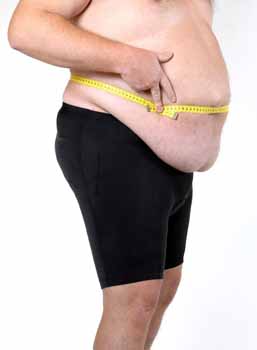Treatment of Obesity
BARIATRIC SURGERY
Bariatric surgery rates have increased substantially, but this procedure may still be underused. Although no long-term randomized trials have been conducted, bariatric surgery is the only treatment that has been reported to result in substantial 10-year weight loss. Bariatric surgery results in long-term reduction in energy intake and is associated with increased physical activity. Furthermore, morbidity from obesity can be altered substantially by bariatric surgery. In a recent systematic review and meta-analysis, Buchwald et al reported that diabetes, hyperlipidemia, hypertension, and obstructive sleep apnea resolved or improved in more than half of the patients who had these conditions preoperatively. Surgery has not been proved to reduce mortality; long-term randomized trials are not yet available to answer this question.
 Mortality rates associated with bariatric surgery are low and vary by type of procedure and surgical experience.
Mortality rates associated with bariatric surgery are low and vary by type of procedure and surgical experience.
Mortality is estimated to be 0.1% for gastric banding, 0.5% for gastric bypass, and 1.1% for biliopancreatic diversion or duodenal switch procedures. Excess weight loss (excess weight = total body weight - ideal body weight) is 47.5% with gastric banding, 61.6% with gastric bypass, and 70.1% with biliopancreatic diversion or duodenal switch procedures. The surgical team and the patient should balance the risks and benefits of these various techniques when selecting the appropriate operation. Both greater surgeon and center experience are associated with reduced mortality and fewer complications. Complications after bariatric surgery are common, and as many as 20% of patients are rehospitalized during the first postoperative year. Short-term complications include wound infection, anastomosis ulceration, stomal stenosis, and constipation, while long-term adverse effects include excessively severe dumping syndrome, nutritional deficiencies, and cholecystitis. When feasible, laparoscopic gastric bypass appears to be more cost-effective than open gastric bypass. Although the initial procedure and treatment of subsequent complications are expensive, medication costs decrease considerably after bariatric surgery, and several investigators have concluded that it is a cost-effective procedure.
Table 1 lists criteria for bariatric surgery. Patients with extreme obesity (BMI, ≥40 kg/m2) and recently diagnosed complications of obesity such as diabetes, metabolic syndrome, and obstructive sleep apnea are particularly good surgical candidates. We recommend a thorough preoperative evaluation by a multispecialty team including nutritionists, psychologists, and surgeons. A detailed preoperative psychological evaluation is necessary because depression is an important potential barrier to sustaining weight loss. Binge-eating disorder should be identified and treated. With good psychosocial support, surgery has been successful in patients with binge-eating disorder. Patients should be educated regarding (1) what to expect from surgery (it typically produces a transition from extreme obesity to mild obesity but rarely results in losses sufficient to attain normal weight), (2) the potential complications of bariatric surgery, (3) postoperative medical therapy (many patients are treated with ursodiol to prevent gallstones, iron supplements, and vitamins to prevent nutritional deficiencies), and (4) the cost of the procedure ($35,000), which is not always covered by insurance. The preoperative evaluation and education process can be expected to take at least 3 to 6 months.
EXERCISE
Physical Activity
Most studies have demonstrated no or modest weight loss with exercise alone (2 kg) or with exercise added to diet (3 kg).50,51 However, 2 studies of longer-duration exercise (90-120 minutes daily) combined with constant energy intake showed weight losses of 7 to 8 kg. The amount of time spent exercising appears to be more important than exercise intensity.
Evidence from randomized trials regarding the importance of exercise in weight maintenance is sparse. However, observational studies suggest that it is crucial. Many prospective studies have demonstrated that regular vigorous physical activity is associated with less weight gain over time in both children and adults and in both men and women. In the National Weight Control Registry of more than 3000 subjects who had maintained an average weight loss of 30 kg for more than 5 years, Wing and Hill found that only 9% did not exercise regularly. The average person in this registry exercised an hour a day. Most walked briskly for exercise (only about 10% ran), and 20% lifted weights. Although resistance training does not help with weight loss, when added to diet and aerobic exercise, it does increase the amount of fat loss. Behavioral psychologists believe that physical activity is the single best predictor of long-term weight maintenance. Therefore, patients should have realistic expectations and avoid becoming discouraged when they exercise; an exercise regimen that is plausible for most patients (30-60 minutes 5-7 days per week) is critical to long-term weight maintenance but is unlikely to result in short-term weight loss beyond what is achieved with dietary change.
Nonexercise Activity Thermogenesis
Energy expenditure consists of resting metabolic rate, the thermic effect of food, and activity thermogenesis, which can be divided into formal exercise and nonexercise activity thermogenesis (NEAT). NEAT comprises all energy expenditure except that used during sleeping, eating, and formal exercise. The dramatic decline in NEAT during the past 100 years corresponds with a similarly dramatic increase in obesity. Automobiles, television, mechanical aids for household chores, and changing workplace environments have reduced energy expenditure by 2092 to 4184 kJ (500-1000 kcal) daily. Another illustration of the impact of NEAT is that theoretically, spending 2 minutes an hour sending e-mail rather than 2 minutes walking down the hall to speak to a colleague results in a 5-kg weight gain in 10 years.
 Obesity has a strong genetic component. Although it is widely believed that genetic differences in resting metabolic rate account for this genetic component, resting metabolic rate does not seem to correlate with obesity. However, genetic differences in NEAT have been documented. In a study of twins who were overfed by 4184 J/d, greater variation in weight gain was observed among twin pairs than within twin pairs, which could not be explained by genetic differences in resting metabolic rate or thermic effect of food. Furthermore, while weight regain is often attributed to a decline in resting metabolic rate, it is better explained by differences in activity level.
Obesity has a strong genetic component. Although it is widely believed that genetic differences in resting metabolic rate account for this genetic component, resting metabolic rate does not seem to correlate with obesity. However, genetic differences in NEAT have been documented. In a study of twins who were overfed by 4184 J/d, greater variation in weight gain was observed among twin pairs than within twin pairs, which could not be explained by genetic differences in resting metabolic rate or thermic effect of food. Furthermore, while weight regain is often attributed to a decline in resting metabolic rate, it is better explained by differences in activity level.
The importance of NEAT has been demonstrated in several studies. A study of 16 subjects who were overfed by 4184 J/d and were not allowed to engage in formal exercise noted significant differences in weight and fat gain, with NEAT explaining about two thirds of the variation. The subjects who exhibited greater increases in spontaneous activity such as walking, fidgeting, and standing gained less weight. A subsequent study demonstrated that sitting motionless, fidgeting while sitting, and walking 1 mile per hour (mph) increased the metabolic rate by 4%, 54%, and 154%, respectively, compared with measurements obtained with the subjects lying down. The difference in energy expended in 1 hour while sitting or walking at 1 mph is about 418.4 kJ/h (100 kcal/h). Finally, a study comparing nonexercising subjects who were thin with nonexercising subjects who were obese demonstrated that the thin subjects were on their feet for at least 2 hours longer each day than the obese subjects. This translates into an energy expenditure difference of 1464.4 kJ/d (350 kcal/d). No randomized trials specifically designed to test the effect of increasing NEAT on weight loss have been conducted.
Tips for increasing NEAT include walking while speaking on the phone, using the stairs rather than the elevator, parking farther from the entrance in parking lots, and walking while watching television or reading. Although having a treadmill at one’s desk sounds far-fetched, typing or using a computer while walking at 1 mph is easy. Given that obesity results in more health care costs than smoking, corporations may want to consider this as an option for their employees.